The 3-2-1 Column: Fixing the offense, sizing up the Coastal and more
MORE HEADLINES - The Morning Pitt: Previewing VT and the Coastal this weekend | Narduzzi talks Virginia Tech, Kenny Pickett and more | Inside the numbers: A closer look at a strong defensive performance | PODCAST: What can Pitt do now? | 2024 four-star receiver visits Pitt | Film review: The issues on offense | Film review: A (mostly) good night for defense | The Morning Pitt: Capel is building an impressive class
In this week’s 3-2-1 Column, we’re thinking a lot about Pitt’s offense - why it has struggled and whether it can improve - as well as the Panthers’ spot in the Coastal Division, Jeff Capel’s recruiting class and more.

THREE THINGS WE KNOW
The biggest question is still the biggest question
I don’t think I was going out on a ledge this summer when I talked about how the fate of the 2022 University of Pittsburgh football Panthers would rest very specifically on the success of the quarterback.
It seemed like an obvious statement, but sometimes the obvious doesn’t end up being the outcome.
This is not one of those times, because the biggest question of the offseason has sequed smoothly - or not so smoothly - into the biggest question of the regular season.
Just like we spent virtually every day from January through August wondering if the offense would be effective enough to win games, we’re now spending every day since wondering the same thing.
There were reasons to at least have a little bit of optimism. I know these reasons well because I recited them so often over the last six months, but let’s hit them again:
A quarterback who was an all-conference performer at the Power Five level
A receiver who was a freshman All-American
An offensive line full of guys older than your average boy band coming in with 100+ combined starts
A potent group of running backs who Just Needed A Chance
An offensive coordinator who promised to return balance
So far…well, the backs have looked pretty good. That is, they’ve looked pretty good when they’ve been healthy and on the field, which is in danger of quickly becoming the minority as the season progresses.
Beyond that, there hasn’t been a lot of confirmation for those expectations.
It’s not all black and white, of course. Kedon Slovis has looked indecisive and uncertain, but he has also made some really sharp throws. Konata Mumpfield has missed some of his marks but has also been a mostly reliable target and has shown flashes of his potential.
When it comes to the offensive line and the offensive coordinator, I would have to say that the jury being out is probably the best case scenario, because if what we’ve seen so far is the finished product, that’s not good.
This is a results-oriented business, and the results are this: 18 touchdowns in five games.
It took Pitt’s offense in 20121 just three games to score 18 touchdowns. By the end of Week Five last season - coincidentally, also a game against Georgia Tech - the Panthers had scored 34 offensive touchdowns.
Now, it’s not fair to compare this offense with that one. That one had a Heisman Trophy finalist and a Biletnikoff Award winner and was the most productive offense in Pitt history. A slide from that production was inevitable and we knew it would happen, but we still wondered about a few things:
How severe would the fall-off be? And would the offense, even with a drop in numbers, still be good enough to win games?
To this point - which is damn near the halfway point of the season - the answer to the first question is “Very severe.” And the answer to the second questions is even more succinct.
“No.”
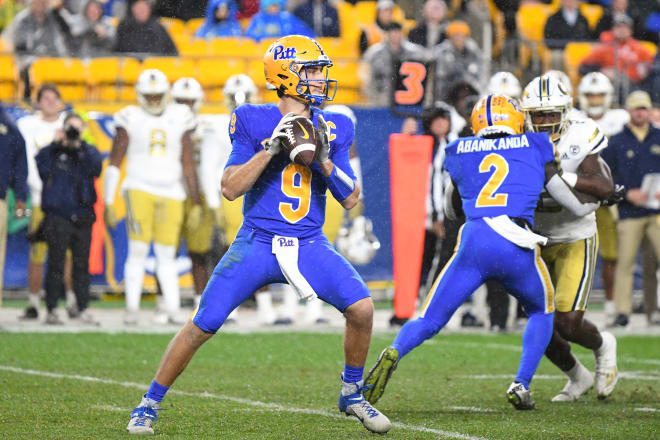
This is what happens (when you lose a superstar in the Alps)
That joke is a deep cut, and you either get it or you don’t. If you don’t, it’s not worth trying to explain.
I don’t think anyone downplayed the significance of losing Kenny Pickett and Jordan Addison this offseason. I really don’t. I think everyone knew how big of a loss Pickett would be when he ran out of eligibility, and I think everyone acknowledged how much it hurt to lose Addison when he opted to transfer to USC.
There were probably some among us who said Pitt would be fine, that the coaches would find other players to step into those roles. And most of the rest of us probably recognized that was a little silly and highly unlikely.
For most of us, the thinking probably went like this:
“It’s going to be next-to-impossible to replace Pickett and Addison, but perhaps in 2022 the whole can be greater than the sum of its parts.”
I was probably in that camp. I’m sure I wrote something like that in a 3-2-1 Column or talked about it on the Panther-Lair Show or muttered it to myself while walking the dog.
Wait. Ignore that last part. I promise I don’t talk to myself about Pitt while walking the dog.
Anyhoo, I bought into the idea that, while Pitt wouldn’t be able to replace Pickett and Addison, the offense could still be quite effective with the personnel and a more balanced attack. Maybe the Panthers wouldn’t need to rely on Herculean performances from two guys; maybe they could get by with really good performances from a bunch of guys.
And maybe that can still happen. The problem is, Pitt hasn’t been getting “really good performances from a bunch of guys” - or any guys, really, when it comes to the offense.
When that happened last season, when some of the play dipped a little too low, the Panthers still survived and even flourished, and the reason they did was twofold.
You can guess the answer here.
It was Pickett and Addison.
If there were any among us who needed a reminder (and why would you?) of just how good those two were, we’re getting it in spades this season, where their absences are being felt almost as much as their presence was last season.
Those two really did a whole lot of heavy lifting for Pitt’s offense and team in 2021. Plenty of guys played well last year. Some played really well. A few had outstanding seasons.
Pickett and Addison were a step above whatever the highest level was that anybody else reached. And if either one of those guys - either one - was on this roster, I have little doubt that Pitt would be 5-0 right now and ranked in the top 10.
But I’m preaching to the choir on this. You all know this. You probably even predicted it.
I guess I’m bringing it up because, in the aftermath of a 3-2 start to the season and a really bad loss, I can’t help but think about the holes left by those two guys. Maybe this is the inevitable result when you lose two players of that caliber.
Pitt might have been the sum of its parts last season, but those two parts were really, really good.
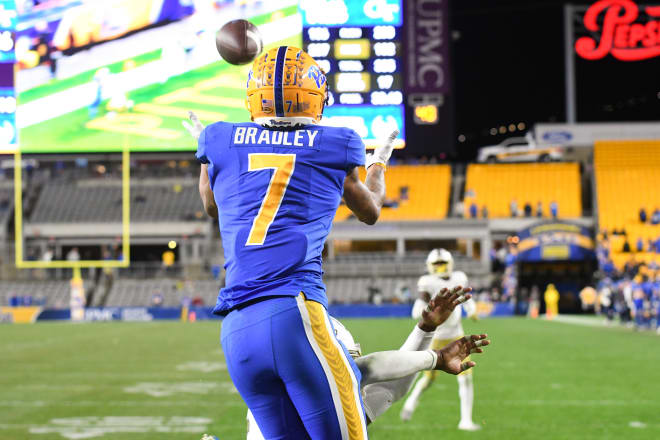
Sourcing the problem
Okay, so far we have established that Pitt’s offense has not been good and it was a major blow to lose Kenny Pickett and Jordan Addison.
Ground-breaking stuff there.
But what, exactly, has been breaking for Pitt’s offense to struggle as mightily as it has?
I think there are a few sources of the problem.
Let’s start up front since, you know, that’s where it all starts.
I’ve been touting the value of the returning experience on the offensive line since Carter Warren, Marcus Minor, Owen Drexel and Gabe Houy decided to return for one more season together. I’ll be the first to admit that. And I’ll be the first to also admit that they have not played well enough.
Not even close.
Kedon Slovis has been under pressure on 37.8% of his drop-backs so far this season. That’s a full 10 percentage points higher than Kenny Pickett saw last season. Teams are blitzing Slovis at about the same rate as they blitzed Pickett, but they’re getting home a whole lot more this year than it did last year.
There’s a caveat, though. You can decide how much you weight you want to put on it, but those four sixth-year seniors - Warren, Minor, Drexel and Houy - have played zero snaps together this season.
Zero.
The excitement about having those four back was based on the idea that they would actually play together. And they haven’t. At all.
Warren, Minor and Drexel were together for the first two games. By Week Three, only Warren and Minor were available for the road trip to Western Michigan. Houy joined those two for the first half of the win over Rhode Island before Warren got hurt. This past week, Minor and Houy were the only two of the four to play against Georgia Tech, and only Minor was in the starting lineup.
With Drexel and Warren up in the air going forward, it’s anyone’s guess when - or if - those four will line up on the field at the same time.
That’s got to be considered when we talk about the disappointment of the offensive line so far.
At the same time, Pitt didn’t exactly replace the missing super seniors with true freshmen. Matt Goncalves has been the primary right tackle in place of Houy, and he’s a redshirt junior. Branson Taylor has stepped in for Warren at left tackle, and he is a little greener as a redshirt sophomore. But both have been touted as talented players, and they were expected to play better than they have.
The offense really does start up front, and the five linemen - whoever they’ve been - haven’t played well enough to give the other players on offense a chance to excel.
Moving back from the line, we won’t completely absolve Slovis here either. He hasn’t looked comfortable this season, and that has carried over to sacks, missed reads and incomplete passes. Some of that is on the guys in front of him; some is on the receivers; and some is straight-up on him.
But there’s a caveat here, too. Slovis played the opener against West Virginia and the first half against Tennessee before missing the second half of that game as well as the game at Western Michigan the next week.
In Week Four, Slovis played, but it’s hard to say he was operating Pitt’s offense when half of his pass attempts - no hyperbole - were thrown behind the line of scrimmage.
As such, I don’t think it’s a stretch to say that Slovis has played basically 2.5 games in Pitt’s “real” offense. With Week Six approaching, that’s not a ton of playing time, and the spread between the second half of the Tennessee game and the Georgia Tech game was a long three weeks.
That’s quite a bit of time between “real” snaps, and it had to have had at least some impact on the cohesiveness of the offense against the Yellow Jackets, at least at the beginning of the game.
Maybe we’re making excuses here, but if we want to get a little more specific than “The OC sucks” as an explanation for Pitt’s offensive struggles so far, I think some of those factors have to be considered.
Pitt’s offense has looked disjointed and out of sync, so the personnel inconsistency on the offensive line and Slovis’ extended absence seem pretty relevant to me. They’re not the entirety of the issues - I don’t think there’s anyone associated with this offense who is beyond reproach right now - but maybe just a little cohesion with that group might translate into some more effective play on the field.
The talent seems to be there for this offense to be more effective than it has been. Sooner or later, it’s bound to coalesce.
Just hope it’s not too late when it does.
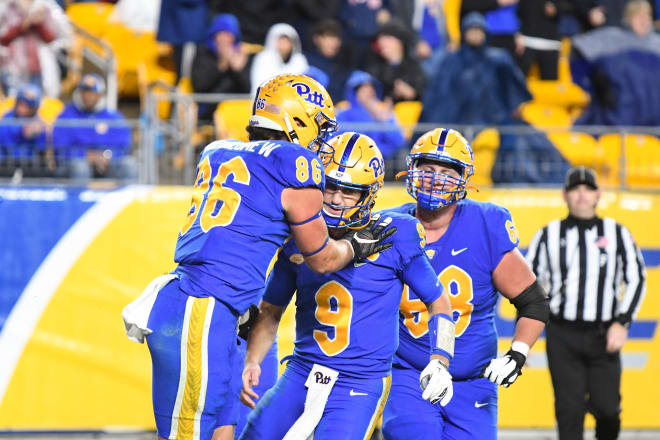
TWO QUESTIONS WE HAVE
How much can you take from two drives?
If you’re looking for silver linings in Pitt’s offense, I would say the second half last Saturday had a few.
Start with the numbers: Kedon Slovis was 20-of-29 for 244 yards, two touchdowns and one interception after halftime. That’s pretty good. And 14 of his 20 completions gained at least 10 yards; that’s pretty good, too, and I think it’s the kind of thing this offense needs to emphasize. Hit more passes in that range and you’ll start getting the passing game into a rhythm from which a lot can grow and flourish.
Then we can get even more specific and hone in on the final two drives in the fourth quarter. Slovis went 10-of-15 for 167 and two touchdowns in that stretch. On paper, those are really good numbers; I don’t think anyone would disagree about that.
The question, though, is how much you can take from those drives. They were late in the fourth quarter with less than four minutes to play in the game, and when the first drive started, Georgia Tech was ahead 19-7. A two-score lead in the fourth quarter is going to lead a defense to play a little differently than it might earlier in the game.
Add in that the first touchdown drive started at the Pitt 1, and the Yellow Jackets were almost certainly conceding some of those 10-yard passes in the interest of keeping Pitt’s offense in front of them and not giving up any quick-strike scores.
Which makes sense.
But at the same time, they couldn’t play too loose. It was a two-score game, but a 12-point lead is different from 14, and once Pitt started picking up first downs, Georgia Tech had to be at least a little concerned about the prospect of the Panthers cutting the score to five - which is ultimately what happened when Pitt went 99 yards in less than two minutes to make it 19-14.
Of course, the momentum was lost one play after the touchdown with a 63-yard run by Georgia Tech, and I do believe the Yellow Jackets were more in “prevent” mode when Pitt got the ball back trailing 26-14.
But Slovis’ success on those two drives has to be worth something. In fact, I would say his success in the entire second half. He wasn’t perfect; he did throw an interception and had a few other misfires. But like the second half against West Virginia and the first half against Tennessee - this season’s oft-cited indicators of the existence of the Good Slovis - there was more good than bad in the second half against Georgia Tech.
Which means the possibility still exists for the elusive Full Good Game from Slovis and the Pitt offense.
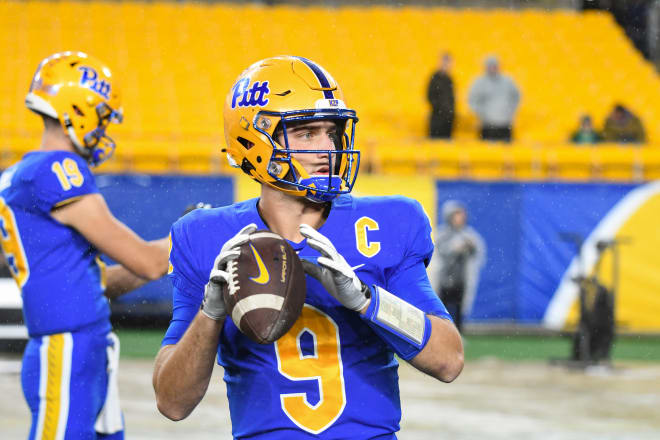
Is there a favorite in the Coastal?
We’re quickly approaching the midpoint of the season, so it’s time to play everyone’s favorite fun game: Who’s good in the Coastal?
More specifically this week, Who is the favorite in the Coastal? Which can turn into, Is there even any team that we should call the favorite in the Coastal?
I’m not sure there is.
In the preseason, Miami was picked to win the division and Pitt was picked to finish second. Five weeks into the season, the Hurricanes and Panthers are a combined 5-4 overall with losses to Middle Tennessee State and interim-led Georgia Tech on their resumes.
So we’re pumping the brakes on that one.
Virginia looks like the bottom of the division at 2-3 overall and with two conference losses already on record. Virginia Tech doesn’t seem much better and is coming to Acrisure Stadium on a two-game losing streak that looks like it should extend into November with this week’s game followed by matchups with Miami and N.C. State.
Georgia Tech played inspired ball last Saturday, but I think that was more a matter of Pitt playing down than the Yellow Jackets playing up, and I imagine they’ll slump through the rest of the season.
That said, Georgia Tech’s game against Duke tomorrow is an interesting one. The Blue Devils have been one of the surprise teams in the Coastal - one of the few with a good record so far - but I don’t think we’re completely sold on them just yet. Going on the road to face what might be a pretty lively crowd in Atlanta will be a good test for Duke; winning there to improve to 5-1 is going to start convincing people, at least a little bit.
And then we have North Carolina. The Tar Heels are 4-1 overall and they have the most productive offense in the ACC, averaging 45 points and 500 yards per game. Their defense has been suspect, but when you can score like that, you’re going to have a chance every week.
UNC has probably the most interesting game in the division and possibly the conference this weekend when the Tar Heels go to Miami for a 4 pm kickoff. If UNC can win, it will put Mack Brown’s group firmly at the top of the division (and, conversely, put Mario Cristobal’s group firmly in the still-above-Virginia bottom of the division). But if Miami wins - and the Hurricanes are favored by 3.5 - then everything gets jumbled again.
Which is what I’m guessing will happen.
My guess is we’ll go into Week Seven with just as many questions about the Coastal as we have now. ESPN’s Football Power Index has Miami as the current favorite to win the division at 40.9%. UNC is second at 29. Pitt (11.4) is fourth behind Duke (14.6).
Nobody in the Coastal is projected to do better than an 8-4 regular-season record.
So yeah, that’s what we’re working with right now. That’s your 2022 Coastal Division, and if it plays out that way, if the division is won by an 8-4 team, then that would seem to be a fitting swan song for this group of programs.
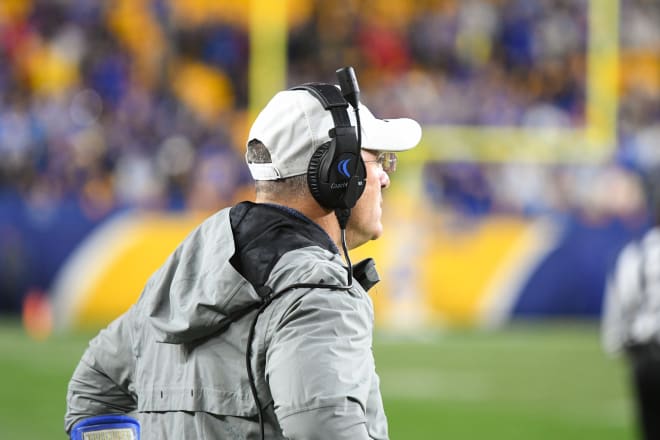
ONE PREDICTION
Pitt’s class won’t always be No. 2
This is a lousy prediction, but sometimes I use this section less as an actual prediction and more as an excuse to talk about a topic I want to cover.
And this week, the topic I want to cover is Pitt’s 2023 recruiting class.
The basketball version.
Because Jeff Capel is, perhaps somewhat quietly, building a really good class.
The latest addition to the class came last Saturday in the person of four-star Texas guard Jaland Lowe. He’s a top-150 prospect and picked Pitt over some pretty good schools, giving the Panthers a second four-star recruit in the class. That pushed Pitt’s class into the top 15 nationally and No. 2 in the ACC.
That’s pretty impressive, especially when the team ahead of Pitt in the conference is Duke, which has five five-stars committed.
Now, team recruiting rankings are based on cumulative points, so quantity can impact the rankings and maybe create a skewed perspective; if one team gets a bunch of commitments early, it’s going to be ranked ahead of other teams that haven’t landed as many commits, even if that smaller class has higher-ranked prospects.
So Pitt is currently No. 2 in the ACC with three commitments, but the 13 teams ranked behind the Panthers have two, one or zero commits. In that sense, quantity is playing a role in Pitt’s ranking.
But there’s a quality element as well. Pitt has two four-star commitments; only two other teams in the ACC have that many (Louisville and Virginia). Duke, of course, has its quintet of five-stars and North Carolina has a five-star of its own, but Pitt is getting high-end prospects as well as anyone in the conference at this point in the cycle.
That’s pretty impressive.
At some point, we all know that UNC will build out its class beyond the current lone commitment. Florida State, Louisville and Virginia, among others, probably will, too. And when that happens, there’s a pretty good chance some of those teams will jump Pitt in the ACC rankings.
So that’s my prediction. But that’s not actually what I came here to say.
I came here to say that Pitt’s class right now is pretty good. Maybe Capel’s best. Lowe and Carlton Carrington can give the Panthers a really strong backcourt. Marlon Barnes still has a lot of potential. And if the coaches can get one of the two bigs they are pursuing, it will top off this class with exactly what Pitt needs for the future.
Like I keep saying, it’s impressive, and maybe this success is even more so since it’s coming on the heels of a fourth consecutive losing season under this coaching staff and a growing sense that Capel’s seat is heating up considerably.
But that hasn’t held the Pitt staff back. From this offseason’s success in filling out the roster with reliable transfers and high-ceiling freshmen to the ongoing success in the 2023 recruiting class, Capel is operating - and succeeding - like a coach who is going to be here for a few more years.
The real story will be told on the court, as we all know. But the offseason work has been as good as ever and seems to be laying the foundation for what should be a turnaround season.
